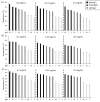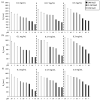Machine learning to determine optimal conditions for controlling the size of elastin-based particles
- PMID: 33737605
- PMCID: PMC7973436
- DOI: 10.1038/s41598-021-85601-y
Machine learning to determine optimal conditions for controlling the size of elastin-based particles
Abstract
This paper evaluates the aggregation behavior of a potential drug and gene delivery system that combines branched polyethyleneimine (PEI), a positively-charged polyelectrolyte, and elastin-like polypeptide (ELP), a recombinant polymer that exhibits lower critical solution temperature (LCST). The LCST behavior of ELP has been extensively studied, but there are no quantitative ways to control the size of aggregates formed after the phase transition. The aggregate size cannot be maintained when the temperature is lowered below the LCST, unless the system exhibits hysteresis and forms irreversible aggregates. This study shows that conjugation of ELP with PEI preserves the aggregation behavior that occurs above the LCST and achieves precise aggregate radii when the solution conditions of pH (3, 7, 10), polymer concentration (0.1, 0.15, 0.3 mg/mL), and salt concentration (none, 0.2, 1 M) are carefully controlled. K-means cluster analyses showed that salt concentration was the most critical factor controlling the hydrodynamic radius and LCST. Conjugating ELP to PEI allowed crosslinking the aggregates and achieved stable particles that maintained their size below LCST, even after removal of the harsh (high salt or pH) conditions used to create them. Taken together, the ability to control aggregate sizes and use of crosslinking to maintain stability holds excellent potential for use in biological delivery systems.
Conflict of interest statement
AVJ and JSC have filed a patent application based on the results reported in this paper.
Figures






References
-
- Telko M, Hickey A. Dry powder inhaler formulation. Respir. Care. 2005;50(9):1209–1227. - PubMed
Publication types
MeSH terms
Substances
Grants and funding
LinkOut - more resources
Full Text Sources
Other Literature Sources

